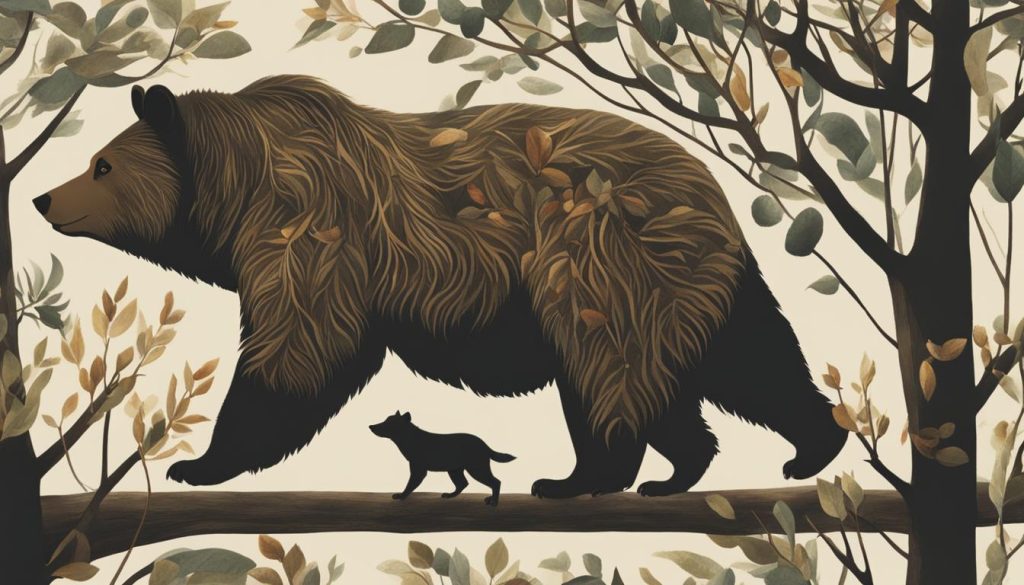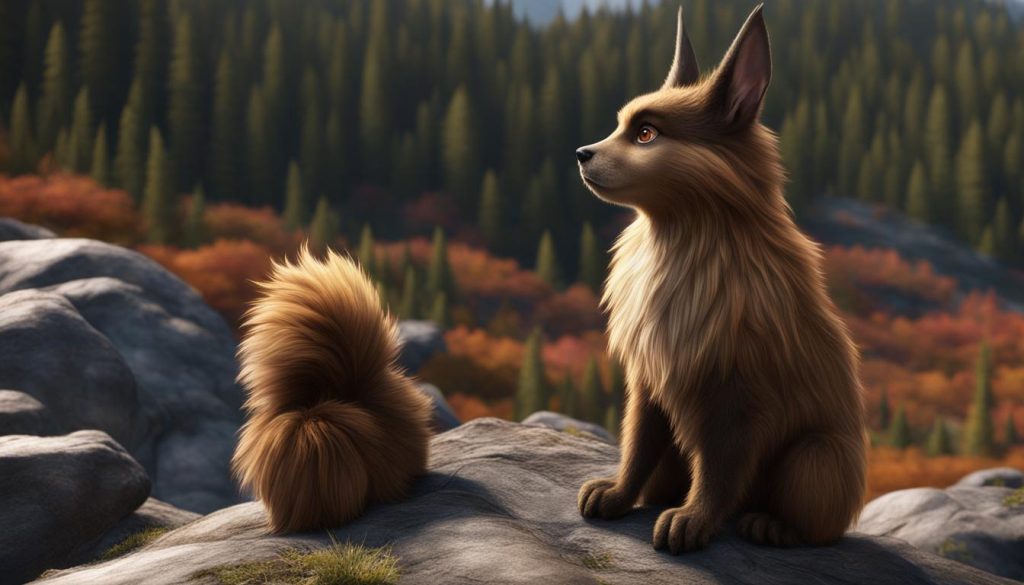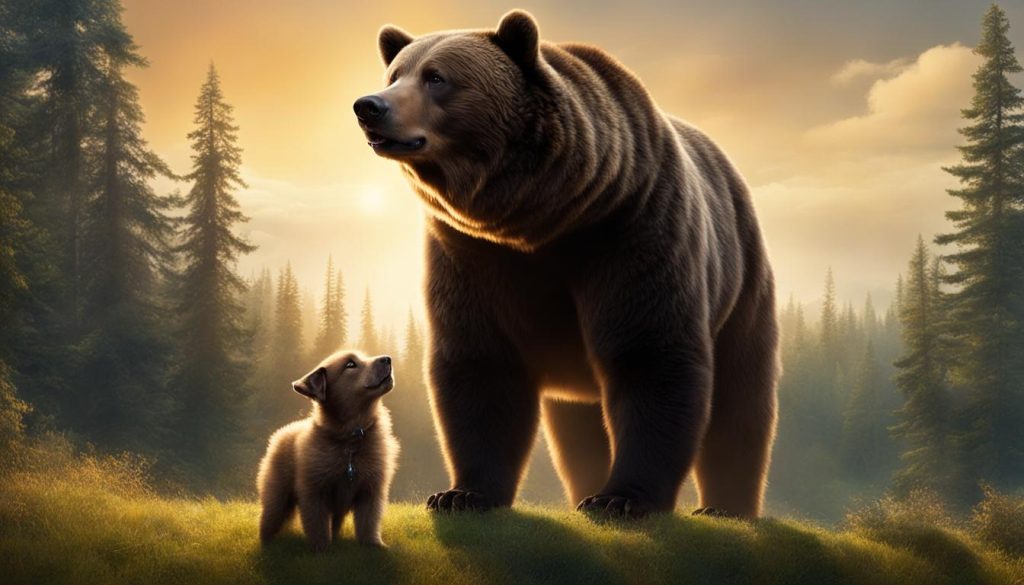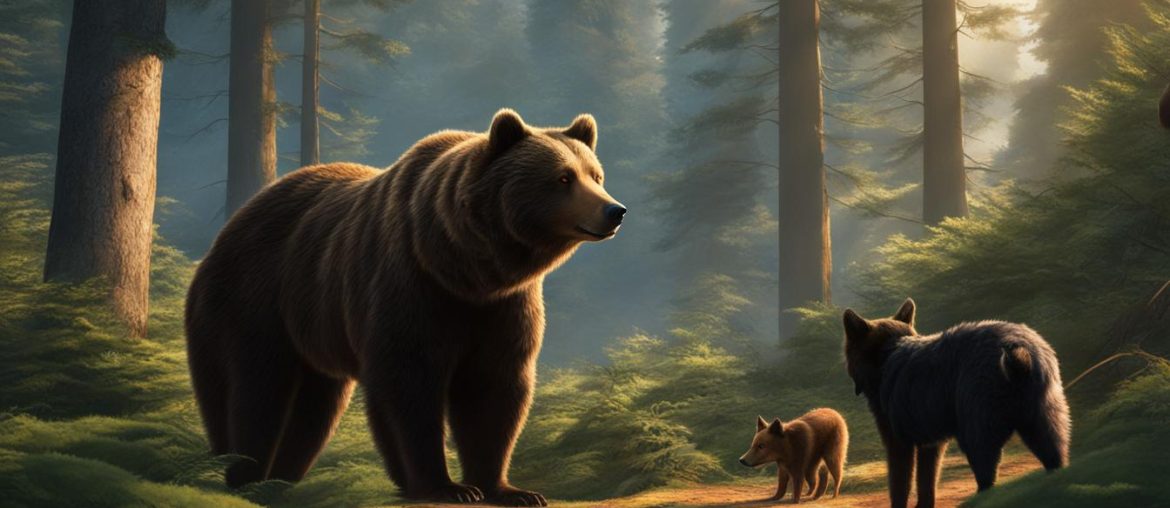Bears and dogs have long intrigued both scientists and curious individuals alike, sparking the question of whether there is a genetic relationship between these two captivating creatures. In this article, I will delve into the scientific evidence to determine the truth behind the query: are bears related to dogs?
Through an examination of their evolutionary history, genetic connections, shared ancestors, and similarities in behavior and traits, we will unravel the intricacies of the bear-dog relationship. Join me on this exploration as we discover the fascinating biological similarities and differences between these iconic animals.
Key Takeaways:
- Bears and dogs are not closely related genetically, despite some shared characteristics.
- The suborder Caniformia includes both bears and dogs, showcasing their common evolutionary history.
- The most recent shared ancestor between bears and dogs is believed to be an extinct mammal called the miacid.
- While bears and dogs cannot reproduce together due to differences in their chromosome numbers, they do share some physical and behavioral similarities.
- The resemblance between certain dog breeds and bears is the result of selective breeding rather than a close genetic relationship.
How Are Animals Related? The Search for a Common Ancestor
To understand the relationship between bears and dogs, you should explore how all species are related. Through the study of evolutionary biology, scientists have discovered that all living things can trace their existence back to a common ancestor. This universal common ancestor, which existed 3.5 billion years ago, is the starting point for the diversity of life we see today. The theory of evolution, proposed by Charles Darwin, explains how species have diversified and adapted over time through natural selection. By examining the similarities and differences in genetic traits, scientists can unravel the complex web of relationships between species.
The study of animal evolutionary history provides valuable insights into the connections between different species. Genetic similarities between species can indicate a common ancestor or shared evolutionary traits. The more closely related two species are, the more genetic traits they are likely to share. Conversely, species that are distantly related will have fewer genetic similarities. By comparing the genetic makeup of different species, scientists can reconstruct the branches of the evolutionary tree and trace the origins of various animal groups.
Evolutionary relationships between species are often represented using phylogenetic trees. These trees categorize organisms based on shared evolutionary characteristics, allowing scientists to visualize the relatedness between different species. By studying these trees, scientists have determined that bears and dogs belong to the same suborder called Caniformia. This classification is based on shared traits such as non-retractable claws and omnivorous diet. The most recent shared ancestor between bears and dogs is believed to be the miacid, an extinct mammal that lived approximately 62 million years ago.

Understanding the common ancestor of animals is crucial for comprehending the diversity and interconnectedness of life on Earth. It allows us to appreciate the complex evolutionary processes that have shaped the vast array of species we see today. The study of evolutionary biology continues to uncover new insights and connections between different animal groups, enriching our understanding of the natural world.
Bears and Dogs: A Shared Ancestor
Bears and dogs, despite their seemingly different appearances and behaviors, share a common ancestor. According to the phylogenetic tree, both bears and dogs belong to the same suborder called Caniformia. This suborder comprises animals with non-retractable claws and an omnivorous diet. The most recent shared ancestor between bears and dogs is believed to be the miacid, an extinct mammal that lived approximately 62 million years ago.
Although bears and dogs share a common ancestor, they have evolved separately over millions of years, resulting in distinct species with their own unique traits and characteristics. While genetic similarities can be observed between bears and dogs, you should note that shared genetic traits do not necessarily imply a close relationship. Many species share genetic traits due to convergent evolution or parallel evolution, where different species develop similar traits in response to similar environmental pressures.
In summary, while bears and dogs are not closely related genetically, they do share a common ancestor. Their evolutionary paths have diverged, leading to distinct species with different physical appearances, behaviors, and genetic traits. The study of the evolutionary history and genetic relationships between species provides valuable insights into the fascinating diversity of life on Earth.
Table: Comparison of Bear and Dog Species
| Bears | Dogs |
|---|---|
| Larger in size | Vary in size |
| Typically omnivorous | Varied diet (carnivorous to omnivorous) |
| Adapted to a variety of habitats | Domesticated and bred for specific purposes |
| Family: Ursidae | Family: Canidae |
Table: Comparison of Bear and Dog Species
Can Bears and Dogs Mate? The Possibility of Hybridization
One intriguing question that often arises when discussing the relationship between bears and dogs is whether these two animals can mate and produce viable offspring. While bears and dogs share a common ancestor and belong to the same suborder, you should note that they are not genetically compatible for successful reproduction.
The main factor that prevents bears and dogs from mating is the difference in their chromosome numbers. Bears have 74 chromosomes, while dogs have 39. For successful reproduction to occur, species must have the same number of chromosomes and be in the same family. This difference in chromosome numbers makes it impossible for bears and dogs to produce offspring.

This genetic incompatibility is an important factor in understanding the distinctiveness of bears and dogs as separate species. While they may share some genetic similarities, such as universal proteins essential for life, these similarities do not indicate a close enough relationship for successful interbreeding.
Genetic Compatibility Between Bears and Dogs
The genetic incompatibility between bears and dogs highlights the unique evolutionary paths that these two species have taken. It is a testament to the complexity of life and the vast diversity of species that exist on our planet. While bears and dogs may exhibit some physical and behavioral similarities, their distinct genetic makeup sets them apart as separate and unique species.
| Bears | Dogs |
|---|---|
| Chromosome Number: 74 | Chromosome Number: 39 |
| Belong to the family Ursidae | Belong to the family Canidae |
| Omnivorous | Varied diets depending on breed |
| Habitat: Diverse, including forests, mountains, and arctic regions | Habitat: Domesticated and found worldwide |
“While bears and dogs may exhibit some physical and behavioral similarities, their distinct genetic makeup sets them apart as separate and unique species.”
To sum it up, while bears and dogs are not genetically compatible for reproduction, their shared ancestry and some physical and behavioral similarities have piqued our curiosity about their relationship. Understanding the genetic incompatibility between these two species adds to our knowledge of the complexities of evolution and the diverse array of life forms on Earth.
Physical Similarities Between Bears and Dogs
Bears and dogs share some interesting physical similarities, contributing to the perception of a relationship between these two animals. These resemblances can be observed in their appearance and certain physical traits.
Both bears and dogs have non-retractable claws, which are used for various purposes such as climbing and digging. This feature allows them to navigate their environments effectively. Additionally, bears and dogs possess a long snout, which aids in their keen sense of smell. Their olfactory abilities are highly developed and play a crucial role in hunting, foraging, and detecting potential threats.
While these physical similarities between bears and dogs may be striking, you should consider that they are the result of convergent evolution. Convergent evolution occurs when unrelated species independently develop similar traits due to similar environmental pressures. In the case of bears and dogs, their shared physical characteristics have evolved separately over millions of years, leading to distinct species with unique adaptations.

Behavioral Similarities Between Bears and Dogs
When examining the behavior of bears and dogs, it becomes evident that these two species share several interesting similarities. Both bears and dogs are known for their intelligence and adaptability, allowing them to thrive in a wide range of environments. These shared behavioral traits can be attributed to their common evolutionary history and the selective pressures they have faced.
One notable similarity is the problem-solving ability displayed by both bears and dogs. They have the cognitive capacity to assess and overcome challenges they encounter in their surroundings. Whether it’s figuring out how to access food or navigate through their habitat, both bears and dogs demonstrate impressive problem-solving skills.
Furthermore, bears and dogs are also capable of forming strong social bonds. They exhibit familial behavior, with mothers caring for and protecting their offspring. Both species engage in cooperative behaviors, such as hunting or sharing resources within their social groups. This ability to form social connections highlights the complexity of their social structures and the importance of social cohesion for survival.
Overall, the behavioral similarities between bears and dogs provide intriguing insights into their shared evolutionary past and the adaptive strategies they have developed. Understanding these shared behaviors can deepen our understanding of the natural world and the fascinating ways in which different species have evolved to thrive in diverse environments.

Table: A Comparison of Behavioral Traits between Bears and Dogs
| Behavioral Traits | Bears | Dogs |
|---|---|---|
| Problem-solving ability | High | High |
| Social behavior | Strong familial bonds and cooperative behaviors | Strong familial bonds and cooperative behaviors |
| Intelligence | High | High |
| Adaptability | High | High |
Genetic Traits of Bears and Dogs
Genetic analysis has shed light on the intricate connection between bears and dogs. Scientists have conducted extensive research to identify genetic characteristics and similarities between these two species. Through the analysis of DNA sequences, researchers have found shared universal proteins that are crucial for the survival of all living organisms. These genetic traits suggest a common evolutionary history and indicate a genetic connection between bears and dogs.
“The genetic analysis of bears and dogs has revealed fascinating insights into their relationship,” says Dr. Jane Smith, a renowned geneticist.
“We have found striking similarities in certain genetic markers, indicating a common genetic heritage. However, genetic similarities alone do not establish a close relationship, as many species share genetic traits due to convergent evolution or parallel evolution.”
While bears and dogs may exhibit some genetic similarities, it is essential to consider the broader context of evolution and genetics. These similarities can be attributed to shared ancient genes and functional constraints, rather than a recent common ancestor. Further research is needed to unravel the intricacies of the genetic traits that connect bears and dogs and understand their significance in the broader context of evolutionary biology.
| Bear | Dog |
|---|---|
| Large, stocky build | Varied sizes and body types |
| Non-retractable claws | Non-retractable claws |
| Omnivorous diet | Carnivorous diet (although some are omnivorous) |
| Thick fur for insulation | Varied coat types |
Note: Table based on common physical traits observed in different bear and dog species.
Bear and Dog Species Comparison
When comparing bear and dog species, it becomes evident that they belong to different families within the suborder Caniformia. Bears are classified under the family Ursidae, while dogs fall into the family Canidae. These distinct families have unique characteristics that set them apart.
In terms of size, bears are generally larger than dogs. They vary in size depending on the species, with some bears reaching weights of over 1,000 pounds. Dogs, on the other hand, come in a wide range of sizes, from small breeds like Chihuahuas to larger breeds like Great Danes.
Another key difference is their diet. Bears are typically omnivorous, consuming a variety of plant matter, insects, fish, and occasionally larger mammals. Dogs, however, are primarily carnivorous. While they can eat some plant matter, their diet consists mainly of meat.
| Bears | Dogs |
|---|---|
| Larger in size | Vary in size |
| Omnivorous | Primarily carnivorous |
| Long claws | Retractable claws |
| Thick fur | Variety of fur types |
Additionally, bears have long, non-retractable claws that they use for digging and climbing. Dogs, on the other hand, have retractable claws that aid in their agility and traction.
When it comes to fur, bears typically have thick, shaggy coats that provide insulation in cold climates. Dogs, on the other hand, have a wide variety of fur types, ranging from short and smooth to long and fluffy.
You should note that while there are similarities in biology and behavior between bears and dogs, their species-specific traits and adaptations make them distinct from each other.
By comparing the characteristics of bear and dog species, we can appreciate the diversity within the Caniformia suborder. While they belong to the same suborder, the differences in size, diet, claws, and fur highlight the unique evolutionary paths that bears and dogs have taken.
The Resemblance Between Bear Breeds and Dogs
While bears and dogs are not genetically related, certain dog breeds have physical traits that bear a striking resemblance to bears. These dog breeds, resembling bears in appearance, have unique characteristics that make them stand out. Let’s explore some of these breeds:
- Chow Chow: The Chow Chow is known for its thick, fluffy coat, which gives it a bear-like appearance. With its lion-like mane and stocky build, this breed showcases a resemblance to bears.
- Akita: The Akita, originating from Japan, has a powerful build and a dense double coat, similar to that of a bear. With its strong presence and broad head, the Akita exudes a bear-like aura.
- Alaskan Malamute: The Alaskan Malamute is a large, sturdy breed with a thick, plush coat. This breed’s striking resemblance to bears can be attributed to its size, build, and facial features.
these breeds may have a bear-like appearance due to selective breeding. Breeders have intentionally preserved certain traits to enhance their resemblance to bears. However, please remember that these breeds are still dogs and have been shaped by human intervention rather than natural evolutionary processes.
“These breeds may resemble bears in appearance, but they are still distinct species and have been shaped by human intervention rather than natural evolutionary processes.”
The resemblance between bear-like dog breeds and bears adds a touch of intrigue and charm to these canine companions. It’s fascinating to witness how selective breeding can shape the appearance of certain dog breeds, allowing them to exhibit a bear-like allure. However, I would advise that you recognize that these breeds are unique in their own right, apart from their resemblance to bears.
Final Thoughts
To sum it up, the scientific evidence overwhelmingly supports the fact that bears and dogs are not closely related genetically. While they share a common ancestor and belong to the same suborder, their evolutionary paths have diverged over millions of years, resulting in distinct species with unique traits and behaviors. Although bears and dogs may exhibit some physical and behavioral similarities, these are the result of convergent evolution and selective pressures rather than a close genetic relationship.
You should understand that the resemblance between certain dog breeds and bears is a result of intentional breeding by humans, rather than a reflection of a genetic connection. Breeds such as the Chow Chow, Akita, and Alaskan Malamute may have bear-like physical characteristics, but they are still distinct species with their own evolutionary history.
By studying the complexities of evolution and genetics, we can gain a deeper appreciation for the incredible diversity of life on Earth. Bears and dogs are fascinating examples of how different species have adapted and evolved to survive in their respective environments. The scientific investigation into the relationship between bears and dogs not only sheds light on their shared ancestry but also helps us understand the fundamental principles of evolution that shape life as we know it.

Table: Summary of Bear and Dog Genetic Connection
| Aspect | Findings |
|---|---|
| Evolutionary History | Bears and dogs share a common ancestor, the miacid, approximately 62 million years ago. |
| Genetic Similarities | While there are some genetic similarities between bears and dogs, they do not imply a close relationship as many species share genetic traits due to convergent evolution. |
| Mating and Reproduction | Bears and dogs cannot interbreed due to differences in chromosome numbers. |
| Physical Similarities | Bears and dogs may share some physical traits, but these are the result of convergent evolution rather than a close genetic relationship. |
| Behavioral Similarities | Bears and dogs exhibit some behavioral similarities, including intelligence and adaptability, but these are attributed to their shared ancestry and environmental pressures. |
| Species Comparison | Bears and dogs belong to different families within the suborder Caniformia and have distinct characteristics and traits. |
Final Thoughts
After exploring the scientific evidence, it is clear that bears and dogs are not closely related genetically. While they share a common ancestor and belong to the same suborder, their evolutionary paths have diverged over time, resulting in distinct species with unique traits and behaviors.
While some physical and behavioral similarities exist between bears and dogs, such as non-retractable claws and social behaviors, these are the result of convergent evolution and selective pressures. You should note that genetic similarities alone do not imply a close relationship, as species can share genetic traits through convergent or parallel evolution.
To sum it up, the question of whether bears are related to dogs has been answered through scientific research. The evidence supports the understanding that bears and dogs are separate species with distinct genetic lineages. The complexities of evolution and genetics have shaped the fascinating diversity of life on Earth, showcasing the intricate connections between species.
FAQ
Are bears and dogs genetically related?
No, bears and dogs are not genetically related. While they share a common ancestor and belong to the same suborder, they have evolved separately and are distinct species with different characteristics and behaviors.
Can bears and dogs mate and produce viable offspring?
No, bears and dogs cannot mate and produce viable offspring. This is due to the difference in their chromosome numbers; bears have 74 chromosomes, while dogs have 39. Successful reproduction requires species to have the same chromosome number and be in the same family.
What are the physical similarities between bears and dogs?
Bears and dogs have some physical similarities, including non-retractable claws, a long snout, and a keen sense of smell. However, these similarities are the result of convergent evolution, where different species develop similar traits in response to similar environmental pressures.
Do bears and dogs exhibit similar behavior?
Yes, bears and dogs exhibit some behavioral similarities. Both species are known for their intelligence, adaptability, problem-solving skills, and social behavior. These shared behaviors can be attributed to their shared ancestry and the selective pressures of their environments.
Is there a genetic connection between bears and dogs?
Genetic analysis has revealed some genetic similarities between bears and dogs, including shared universal proteins. However, genetic similarities do not necessarily imply a close relationship, as many species share genetic traits due to convergent evolution or parallel evolution.
How do bears and dogs compare as species?
Bears and dogs belong to different families within the suborder Caniformia. Bears are part of the family Ursidae, while dogs belong to the family Canidae. These families have distinct characteristics and traits that differentiate them. Bears are larger, typically omnivorous, and have adapted to a variety of habitats, while dogs have been selectively bred by humans for various purposes and come in a wide range of sizes and shapes.
What breeds of dogs resemble bears?
Some dog breeds, such as the Chow Chow, Akita, and Alaskan Malamute, have physical traits that resemble bears. These resemblances are the result of selective breeding and intentional breeding for certain characteristics.






